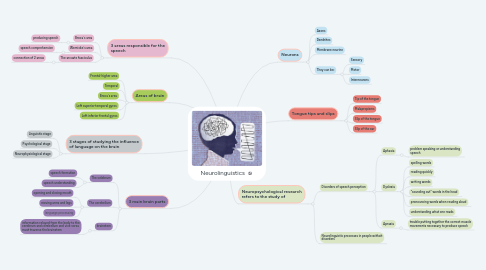Neurolinguistics
by diana gimadieva


1. 3 areas responsible for the speech
1.1. Broca`s area
1.1.1. producing speech
1.2. Wernicke`s area
1.2.1. speech comprehension
1.3. The arcuate fasciculus
1.3.1. connection of 2 areas
2. 3 stages of studying the influence of language on the brain
2.1. Linguistic stage
2.2. Psychological stage
2.3. Neurophysiological stage
3. Areas of brain
3.1. Frontal-higher area
3.2. Temporal
3.3. Broca`s area
3.4. Left superior temporal gyros
3.5. Left inferior frontal gyros
4. 3 main brain parts
4.1. The celebrum
4.1.1. speech formation
4.1.2. speech understanding
4.2. The cerebellum
4.2.1. opening and closing mouth
4.2.2. moving arms and legs
4.2.3. language processing
4.3. brainstem
4.3.1. information relayed from the body to the cerebrum and cerebellum and vice versa must traverse the brainstem
5. Neuropsychological research refers to the study of
5.1. Disorders of speech perception
5.1.1. Aphasia
5.1.1.1. problem speaking or understanding speech
5.1.2. Dyslexia
5.1.2.1. spelling words
5.1.2.2. reading quickly
5.1.2.3. writing words
5.1.2.4. "sounding out" words in the head
5.1.2.5. pronouncing words when reading aloud
5.1.2.6. understanding what one reads
5.1.3. Apraxia
5.1.3.1. trouble putting together the correct muscle movements necessary to produce speech
5.2. Neurolinguistic processes in people withoit disorders
6. Neurons
6.1. Axons
6.2. Dendrites
6.3. Membrane neurine
6.4. They can be:
6.4.1. Sensory
6.4.2. Motor
6.4.3. Interneurons
